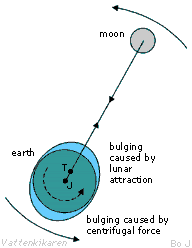 |
|
Salts are heavy. The higher the salt content of the water, the higher its
density, which means that a given volume of saltwater will weigh more than
the same volume of freshwater. In addition, cold seawater is heavier than
warmer seawater.
 A halocline, a layering of water
depending on its salt content, is a boundary between heavy saltwater lying
under a layer of less saltier and lighter water. A thermocline, a
layering of the water depending on its temperature, is a boundary between
the underlying, heavier and colder water and the lighter and warmer water
above. At low temperatures and salt content special circumstances exist,
for example, water just a few degrees above zero can lay above warmer water.
A halocline, a layering of water
depending on its salt content, is a boundary between heavy saltwater lying
under a layer of less saltier and lighter water. A thermocline, a
layering of the water depending on its temperature, is a boundary between
the underlying, heavier and colder water and the lighter and warmer water
above. At low temperatures and salt content special circumstances exist,
for example, water just a few degrees above zero can lay above warmer water.
The sea moves
Because of varying factors,
water seldom stands still. This can happen when the sun unevenly heats
the earth and creates winds and currents. Furthermore, tidal currents
occur when the sun and moons gravitational pull effect the seas.
The earth and the moon rotate around a common axis that
is slightly displaced from the earths centre. Gravitational forces
work against each other, while centrifugal force press them apart.
At the centre of the earth, equalibrium exists between these forces,
but on the side of the earth facing the moon, an attractive (pull)
force dominates, while on the opposite side a centrifugal force dominantes.
Therefore, there are "proturberances" on both sides of the
earth, as portrayed in the digram to the right. The earths rotation
round its axis results in that we experience as two
high and two low tides daily. The gravitational pull is about
half of the moons. When there is a full or new moon, the sun and the
moon are in line with each other. |
At this time both planets
work together, resulting in a spring tide. When there is a
half moon, the difference between high and low tide is the smallest
because the gravitational pull from the sun and moon counteract each
other. This is known as a nip tide.

Simplified model of how tides occur. T is the earths and moons common
centre of gravity, J is the earths centre.
|
 |
Page
6 of 28 |
 |
|



